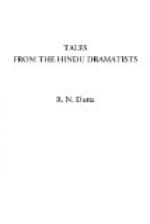In comparison with the Greek and the modern drama, Nature occupies a much more important place in Sanskrit plays. The characters are surrounded by Nature, with which they are in constant communion. The mango and other trees, creepers, lotuses, and pale-red trumpet-flowers, gazelles, flamingoes, bright-hued parrots, and Indian cuckoos, in the midst of which they move, are often addressed by them and form an essential part of their lives. Hence the influence of Nature on the minds of lovers is much dwelt on. Prominent everywhere in classical Sanskrit poetry, these elements of Nature luxuriate most of all in the drama.
The dramas of Bhavabhuti except Malati-Madhava, and the whole herd of the later dramatic authors, relate to the heroic traditions of the Ramayana and the Mahabharata, or else to the history of Krishna; and the later the pieces are, the more do they resemble the so-called ‘mysteries’ of the middle ages. The comedies, which, together with a few other pieces, move in the sphere of civil life, form, of course, an exception to this. A peculiar class of dramas are the philosophical ones, in which abstractions and systems appear as the dramatis personae. One very special peculiarity of the Hindu drama is that women, and persons of inferior rank, station, or caste are introduced as speaking the Prakrit or vulgarised Sanskrit, while the language of the higher and more educated classes is the classical Sanskrit of the present type.
THE CONSTRUCTION OF THE SANSKRIT DRAMA.
According to the code of criticism laid down in works on Sanskrit drama, it should deal principally either with the sentiment of love, or the heroic sentiment; the other sentiments should have a subsidiary position. There should be four or five principal characters, and the number of acts should vary from five to ten.
There are several species of the drama,—ten principal, and eighteen minor. Of these none has a tragic end.
Every drama opens with a prologue or, to speak more correctly, an introduction designed to prepare the way for the entrance of the dramatis personae. The prologue commences with a prayer or benediction (Nandi) invoking the national deity in favour of the audience.
Then generally follows a dialogue between the stage-manager and one or two of the actors, which refers to the play and its author, mentions past events and present circumstances elucidating the plot, and invariably ends by adroitly introducing one of the dramatic personages, and the real performance begins.




